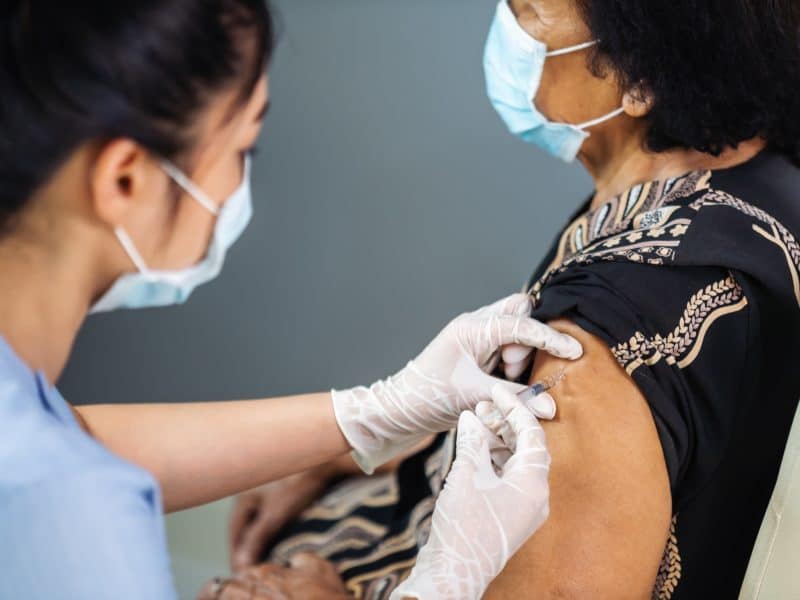December 20, 2021

MRSA- and MSSA-related septicemia hospitalizations are increasing in the United States. Methicillin-resistant Staphylococcus aureus (MRSA) and Methicillin-susceptible Staphylococcus aureus (MSSA) are associated with high morbidity and mortality. A recent study led by CDDEP researchers shows that MRSA-related septicemia hospitalizations have increased by 18% between 2017 and 2019, while MSSA-related septicemia hospitalizations increased over 25% in the same period. MSSA-related pneumonia hospitalizations fluctuated but did not increase between 2016-2019, while MRSA-related skin and soft tissue infections decreased by 23%. Notable regional differences were identified for both MRSA- and MSSA-related hospitalizations. [Open Forum Infectious Diseases]
New KVASU e-compendium supports zoonoses management. Recognizing the importance of a One Health approach to disease surveillance, prevention, and control, Kerala Veterinary and Animal Sciences University, in collaboration with the National Institute of Agricultural Extension Management in Hyderabad, developed an e-compendium as part of a training program for the management and control of zoonoses and animal health threats. The e-compendium compiles a list of information communication tools, including CDDEP’s ResistanceMap. [KVASU & MANAGE]
Heterologous vaccination provides protection against COVID-19. Homologous and heterologous COVID-19 vaccine administration was performed using AstraZeneca, Pfizer, Moderna, or NovaVax vaccines. The adenovirus-based AstraZeneca vaccine was associated with greater interferon-γ production, potentially resulting in longer immunological protection, but mRNA vaccines were found to produce more neutralizing antibodies. Pfizer-Moderna heterologous vaccination produced the greatest immune response. Given its safety and efficacy, heterologous vaccination has the potential to help improve equitable vaccine distribution worldwide. [The Lancet]
COVID-19 and diabetes in Africa: a lethal combination Despite not being more vulnerable to infection, diabetics infected with COVID-19 are at increased risk of death in Sub-Saharan Africa, with a fatality rate of 10.2% compared to the overall fatality rate of 2.5%. Increased risk is associated with multiple factors including cost of care, disrupted health services, lack of access to healthcare facilities or telemedicine alternatives. Given the association between uncontrolled diabetes and cardiovascular disease, diabetes care should be prioritized during this pandemic and considered when planning for future emergencies. [The Lancet Diabetes and Endocrinology]
Universal masking can effectively minimize COVID-19 transmission. Researchers at the Max Planck Institute in Germany assessed the risk of infection with COVID-19 based on several masking and social distancing scenarios, using the average estimated viral load and infectious dose. Face masks significantly reduced the risk of infection compared to social distancing alone, which had an upper bound of 90% for risk of infection after a few minutes even at 3.0 m between two speaking individuals. Correctly fitted surgical and FFP2-type masks had an upper bound for risk of infection of 30% and 0.4% after one hour, providing evidence that mask wearing is an important measure to protect oneself and others. [PNAS]
Community engagement facilitates antimicrobial resistance behavior changes in low- and middle-income countries. Antimicrobial resistance is a One Health issue partially driven by social and systemic factors. However, in low- and middle-income countries, community engagement can facilitate behavioral changes around antimicrobial use and enable the development of economically feasible, socially acceptable, and culturally appropriate solutions. Open access resources related to evaluation, stakeholder mapping, and communication could promote scalable and sustainable community engagement approaches. [Global Public Health]
Urine, genital, and skin specimens can be used for rapid, scalable AMR surveillance. Antimicrobial resistance (AMR) surveillance through blood specimens is challenging due to cost, processing, and other limitations. However, specimens collected from urine, genitals, and skin are cheaper and easier to collect and process and are more likely to be culture positive. A recent study found an association between AMR prevalence in commensal opportunistic pathogens isolated from blood samples and other body sites; the association was similar for most antibiotics and consistent over time and across various economic contexts. [Scientific Reports]
More political action is needed to combat antimicrobial resistance (AMR). A knowledge, attitudes, and perceptions survey was distributed to 351 politicians, policy advisors, and stakeholders from 15 high-, middle-, and low-income countries. Participants from low- and middle-income countries demonstrated better knowledge of AMR compared to high-income countries but had comparatively poor attitudes toward antimicrobial use. Education and expertise were significantly associated with knowledge, perception, and practices regardless of country of origin. While all represented countries had a National Action Plan on AMR at the time of the survey, only one in three participants was aware of its existence, warranting awareness interventions to encourage political action to combat AMR. [Antibiotics]
Neutralizing antibody levels can be used to identify risk of COVID-19 infection. Neutralizing antibody levels have been shown by many studies to correlate with protection against SARS-CoV-2, however, lack of common standards hinders the determination of the exact levels required for protection. Use of assays like cPass, an FDA-approved surrogate virus neutralization test calibrated to WHO international standards, can support risk assessment, particularly given the spread of different variants. Several thresholds have been identified, but further validation in larger studies is needed. Eventually, neutralizing antibody levels can act as a biomarker for different populations regardless of COVID-19 vaccine type or homologous or heterologous vaccination. [The Lancet Microbe]
COVID-19 antivirals must not affect HIV drug supply. Emergency Use Authorization of an oral COVID-19 drug boosted with low dose ritonavir (a drug used to treat HIV and hepatitis), could increase market uncertainty, volatility, and prices, affecting HIV treatment and prevention. Countries excluded from the license that do not have domestic ritonavir manufacturing will be particularly affected. To prevent disruptions, parent company Pfizer should confirm the global capacity to manufacture this drug, make procurement, supply, prices, and global registration information publicly available, and not enforce patents in low- and middle-income countries for the duration of the pandemic. National procurement agencies can assist by anticipating shortages and reallocating stock, while high-income countries can increase HIV treatment funding to offset price increases. [The Lancet HIV]
Photo: Shutterstock











